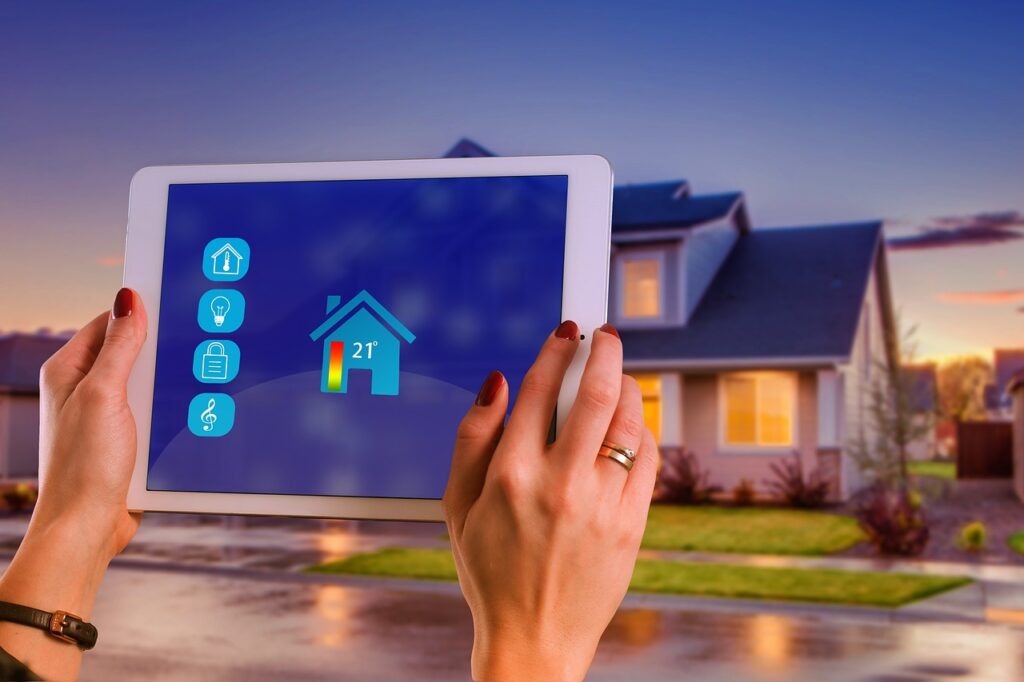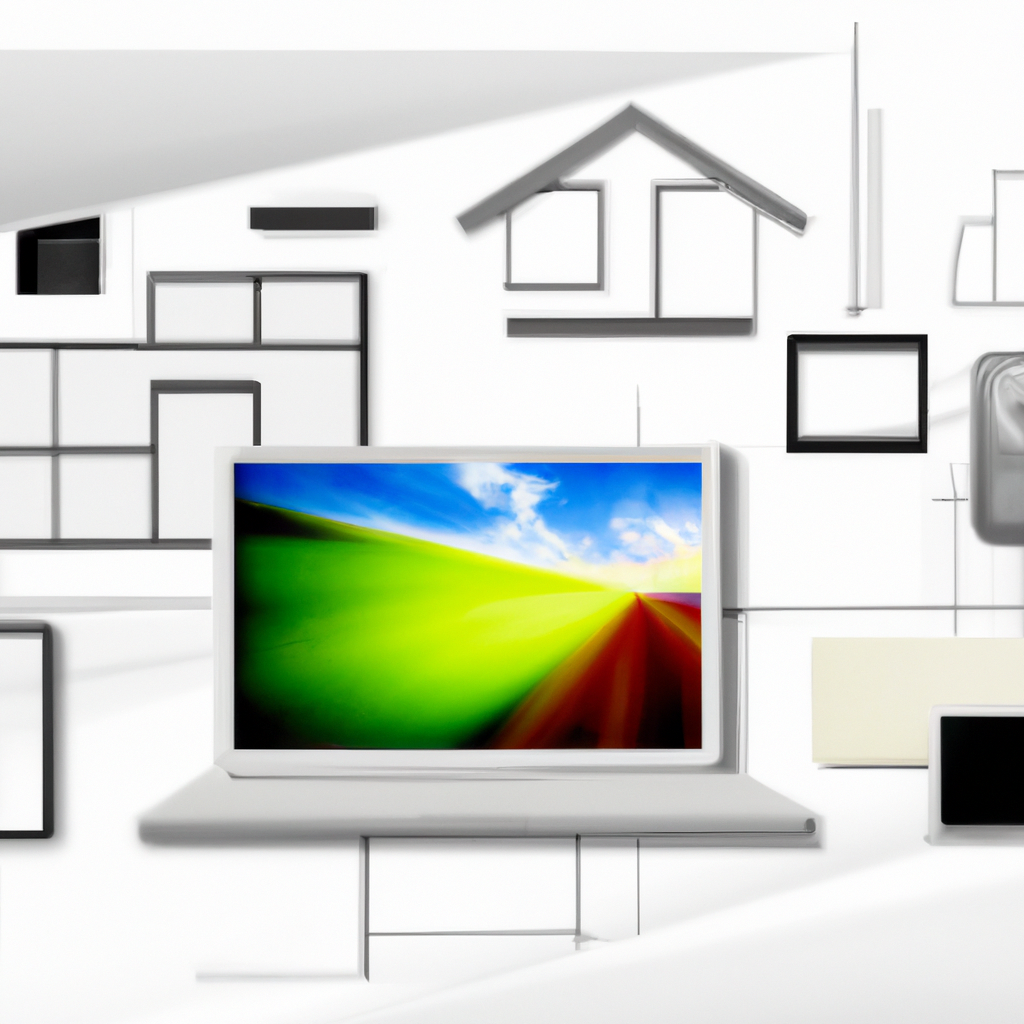Looking to dip your toes into the world of home automation? Curious about whether there are affordable options available for beginners? Well, you’re in luck! This article will explore the realm of home automation and highlight some accessible and budget-friendly choices that will help you kickstart your journey into transforming your house into a smart home. So, if you’ve been itching to add a touch of convenience and modernity to your living space without breaking the bank, keep reading to discover the exciting possibilities that await you.
1. The Benefits of Home Automation
Home automation offers a wide range of benefits that can greatly enhance your daily life. From increased convenience and efficiency to enhanced security and energy savings, home automation has become an increasingly popular choice for homeowners. Let’s explore these benefits in more detail.
1.1 Increased Convenience and Efficiency
One of the key advantages of home automation is the increased convenience it brings to your everyday life. With home automation systems, you can control various aspects of your home with just a few taps on your smartphone or using voice commands. Imagine being able to adjust the lighting, temperature, and even the music playing in each room of your house with a simple command.
Home automation also allows for greater efficiency in managing your home. With programmable schedules and timers, you can automate tasks such as turning on/off lights, adjusting thermostats, and even watering your plants. This not only saves time but also ensures that energy is used efficiently, leading to cost savings in the long run.
1.2 Enhanced Security
Another major benefit of home automation is the added security it provides. Home automation systems often include features such as remote monitoring, motion sensors, and video surveillance. These components work together to create a comprehensive security system that gives you peace of mind.
With remote monitoring, you can keep an eye on your home even when you’re away. Receive notifications on your smartphone if there’s any unusual activity or if a sensor is triggered. This allows you to take immediate action and alert the authorities if needed.
In addition to monitoring, home automation systems can integrate with smart door locks and security cameras, providing an extra layer of protection. You can remotely lock/unlock your doors and check who’s at your front door using your smartphone or a compatible device. This level of control over your home’s security is invaluable.
1.3 Energy and Cost Savings
Home automation is not only convenient and secure but also energy-efficient. By automating and controlling various devices and systems in your home, you can optimize energy usage and reduce wastage. This ultimately leads to cost savings on your energy bills.
Smart thermostats, for example, allow you to set schedules and adjust the temperature settings in your home remotely. This means you can ensure your heating or cooling systems are only running when necessary, saving both energy and money.
Similarly, smart plugs and smart bulbs enable you to turn off appliances and lights that are not in use, reducing standby power usage. With the ability to monitor and control your energy consumption, you can make smarter choices to minimize waste and increase efficiency.
1.4 Remote Monitoring and Control
One of the most significant advantages of home automation is the ability to remotely monitor and control your home. With a compatible app or a web-based control panel, you can access and manage your home automation system from anywhere in the world.
Whether you’re at work, on vacation, or simply in another room, you can check the status of your devices and make adjustments as needed. Forgot to turn off the lights before leaving? No problem. Just open the app and switch them off.
Furthermore, remote control goes beyond just convenience. It allows you to create the illusion that someone is home even when you’re away, deterring potential burglars. You can turn on lights, adjust blinds, and even play music to make it seem like someone is present.
2. Types of Home Automation Systems
Home automation systems come in various types, each offering different levels of complexity and functionality. Let’s explore the three main types:
2.1 Standalone Systems
Standalone home automation systems are typically the simplest and most affordable option for beginners. These systems consist of individual devices that can be controlled independently. Smart plugs, smart bulbs, and smart thermostats are examples of standalone devices that can be connected to your home network.
While standalone systems offer basic automation capabilities, they usually lack the advanced features and seamless integration found in more comprehensive setups. Nonetheless, they serve as a great starting point for those who want to dip their toes into the world of home automation without investing too much upfront.
2.2 Hub-Based Systems
Hub-based systems, also known as central systems, offer a more integrated and comprehensive approach to home automation. These systems use a central hub or controller that acts as the brain of the setup, connecting and managing all the devices within the system.
With a hub-based system, you can control multiple devices and create more complex automation scenarios. For example, you can set up “scenes” that activate multiple devices simultaneously, such as turning off the lights, locking the doors, and arming the security system with a single command.
Hub-based systems often support a wide range of devices and protocols, making them highly versatile and compatible with various brands. However, they do require some initial setup and configuration to get the system up and running.
2.3 Voice-Controlled Systems
Voice-controlled home automation systems have gained popularity in recent years, thanks to advancements in natural language processing and voice recognition technology. These systems allow you to control your home automation devices using voice commands, making it incredibly convenient and intuitive.
Voice-controlled systems typically work in conjunction with a virtual assistant, such as Amazon Alexa, Google Assistant, Apple Siri, or Microsoft Cortana. By simply speaking commands or asking questions, you can control your devices, play music, access information, and much more.
While voice-controlled systems offer a hands-free and user-friendly experience, they often require compatible devices with built-in voice assistants or separate smart speakers to interact with. Additionally, these systems heavily rely on a stable internet connection for seamless operation.

3. Affordable Home Automation Brands
When it comes to affordable home automation, there are several reputable brands that offer a range of products and systems suitable for beginners. Let’s take a look at some of these brands:
3.1 Wyze
Wyze is a brand known for its affordable yet feature-packed smart home devices. They offer a wide range of products, including smart plugs, smart bulbs, cameras, and even a wireless home security system. Wyze devices integrate with popular voice assistants, allowing for seamless control and automation.
3.2 TP-Link Kasa
TP-Link Kasa is a trusted brand offering a range of smart home devices, particularly in the area of lighting and energy management. Their lineup includes smart plugs, smart bulbs, and smart switches that can be controlled remotely for convenience and energy savings. TP-Link Kasa also integrates with major voice assistants.
3.3 Wink
Wink is a smart home platform that works with various brands and devices, providing a unified control interface. The Wink Hub 2 acts as the central controller, allowing you to effortlessly manage your connected devices from one place. With compatibility with popular protocols like Z-Wave, Zigbee, and Wi-Fi, Wink offers flexibility and expandability.
3.4 Xiaomi
Xiaomi, a well-known Chinese brand, offers a range of affordable smart home products for beginners. From security cameras and sensors to smart plugs and light bulbs, Xiaomi provides an extensive lineup that integrates with their dedicated Mi Home app. While Xiaomi devices are popular, they may require some technical expertise to set up and configure.
3.5 Broadlink
Broadlink specializes in universal remote controls and home automation solutions. Their devices, such as the Broadlink RM Pro, allow you to control various infrared and RF devices, including TVs, air conditioners, and more, from your smartphone. Broadlink offers a budget-friendly option for those looking to automate their existing appliances.
These brands provide affordable options for beginners interested in home automation. By choosing products from these reputable brands, you can start building your home automation setup without breaking the bank.
4. Entry-Level Home Automation Devices
Now that we’ve explored the benefits of home automation and the different types of systems available, let’s delve into some entry-level devices that are perfect for beginners.
4.1 Smart Plugs
Smart plugs are one of the easiest and most versatile devices to start with. These plugs fit into your existing electrical outlets and allow you to control the power supply to connected devices. With remote control capabilities, you can turn on/off devices such as lamps, fans, or coffee makers from anywhere.
Smart plugs are often compatible with voice assistants and can be integrated into automation scenes. For example, you can set a schedule to automatically turn on a lamp in the evening or create a “goodnight” scene that switches off all the connected devices before you sleep.
4.2 Smart Bulbs
Smart bulbs are another excellent entry-level device for home automation enthusiasts. With smart bulbs, you can control the brightness and color of your lighting with a smartphone app or voice commands. This allows you to create different lighting scenes and moods according to your preference.
Some smart bulbs even have features like scheduling, motion detection, and sunrise/sunset simulation. You can set your lights to gradually brighten in the morning to wake you up naturally. Additionally, smart bulbs are energy-efficient, offering long lifespans and reducing electricity consumption.
4.3 Smart Thermostats
Smart thermostats provide a convenient solution for controlling your home’s heating and cooling systems. With these devices, you can set customized schedules, adjust the temperature remotely, and even enable location-based automation.
Smart thermostats often include features like energy usage tracking, adaptive learning, and compatibility with voice assistants. By optimizing your home’s temperature settings, you can save on energy costs while maintaining a comfortable environment.
4.4 Smart Door Locks
Smart door locks offer enhanced security and convenience, as you no longer need physical keys to unlock your doors. These locks can be controlled remotely through a smartphone app or via voice commands. You can grant temporary access codes for guests, receive notifications when someone unlocks the door, and even unlock the door from anywhere.
Smart door locks often come with additional features such as doorbell cameras, built-in alarms, and integration with security systems. They provide peace of mind, knowing that your home is secure and easily accessible.
4.5 Smart Home Security Cameras
Smart home security cameras are a crucial component of any home automation setup. These cameras allow you to monitor your home remotely and provide visual evidence in case of any security incidents. They often feature motion detection, night vision, and two-way audio communication.
With smart security cameras, you can receive real-time alerts on your smartphone when the camera detects activity. You can also view the camera feed and communicate with people at your doorstep, even when you’re away from home.
By incorporating these entry-level home automation devices into your home, you can start experiencing the convenience, security, and energy savings that home automation offers.

5. DIY Home Automation Solutions
For those who enjoy a hands-on approach or are looking for more customization options, DIY home automation solutions are an excellent choice. Here are some popular choices:
5.1 Raspberry Pi
Raspberry Pi is a small and affordable computer that can be used for various DIY projects, including home automation. By connecting sensors, actuators, and other components to a Raspberry Pi board, you can create your own home automation system tailored specifically to your needs.
With the Raspberry Pi’s GPIO pins and a programming language like Python, you can control devices, sensors, and triggers. Whether you want to measure temperature, control lights, or automate tasks, Raspberry Pi provides endless possibilities for DIY enthusiasts.
5.2 Arduino
Arduino is another popular DIY platform for home automation and electronics projects. Similar to Raspberry Pi, Arduino boards can be programmed to interact with various components and devices. From simple tasks like controlling lights to more complex automation scenarios, Arduino provides a flexible and accessible solution.
Arduino boards offer a range of options to choose from, depending on your project’s requirements. With its extensive community and vast library of sketches, you can find numerous resources and tutorials to help you get started with Arduino-based home automation projects.
5.3 Home Assistant
Home Assistant is an open-source home automation platform that acts as a central hub for controlling and automating devices in your home. It supports a wide range of devices, protocols, and integrations, allowing you to create a customized and powerful home automation system.
With Home Assistant, you can connect devices from different brands and control them from a single interface. It offers advanced automation capabilities, geolocation support, and integration with popular voice assistants.
However, setting up and configuring Home Assistant can be more involved compared to off-the-shelf solutions. It requires some technical knowledge, but the flexibility and customization options it provides make it a favorite among DIY enthusiasts.
Whether you choose Raspberry Pi, Arduino, or Home Assistant, DIY home automation solutions allow you to explore and experiment with different devices and automation scenarios. With a bit of creativity and technical know-how, you can create a personalized smart home setup that meets your specific needs.
6. Affordable Home Automation Starter Kits
While individual devices offer great flexibility, some beginners prefer the convenience and cost-effectiveness of starter kits that provide a complete home automation solution right out of the box. Here are some affordable starter kits to consider:
6.1 Wyze Starter Kit
Wyze offers a starter kit that includes several of their popular devices, such as smart plugs, smart bulbs, and a wireless home security system. With this kit, you can begin automating your home and enhancing security without having to purchase each device separately. It’s a great way to jump-start your home automation journey.
6.2 TP-Link Kasa Smart Home Starter Kit
TP-Link Kasa also provides a comprehensive starter kit that includes smart plugs, smart bulbs, and a hub. This kit allows you to control lighting, appliances, and other devices, creating a connected and convenient home environment. With the included hub, you can expand and integrate additional Kasa devices as your needs grow.
6.3 Samsung SmartThings Starter Kit
Samsung SmartThings is a popular home automation ecosystem, and their starter kit offers a glimpse into its capabilities. The kit includes a hub, a motion sensor, two multipurpose sensors, and an outlet. This allows you to monitor motion, changes in temperature, and more. Samsung SmartThings provides an intuitive and user-friendly experience, making it ideal for beginners.
6.4 Amazon Echo Plus Bundle
Amazon Echo Plus is a smart speaker that doubles as a hub for your connected devices. The Echo Plus Bundle includes the smart speaker, two Philips Hue smart bulbs, and a smart plug. With the Echo Plus, you can control your devices using voice commands, play music, and access a wide range of skills and services.
6.5 Google Nest Hub Max Starter Pack
Google Nest Hub Max combines the functionalities of a smart display and a hub. The starter pack includes the Nest Hub Max, two Phillips Hue White & Color Ambiance bulbs, and a Google Nest Mini. With the Google Nest Hub Max, you can control your devices, watch videos, and use Google Assistant for a seamless smart home experience.
These affordable starter kits provide all the essentials you need to begin your home automation journey. They offer a combination of devices and a central hub, giving you a glimpse into the possibilities of a fully automated home.

7. Home Automation Compatible Voice Assistants
Voice assistants have become an integral part of many home automation setups, allowing for convenient and hands-free control of your devices. Here are some popular voice assistants that are compatible with home automation:
7.1 Amazon Alexa
Amazon Alexa is perhaps the most widely recognized voice assistant, thanks to the popularity of Amazon Echo devices. Alexa can control a wide range of smart home devices, from lights and thermostats to security cameras and kitchen appliances. You can issue commands, ask for information, and enjoy a host of other skills and features.
7.2 Google Assistant
Google Assistant is Google’s voice assistant, available on various devices such as Google Home speakers and Android smartphones. With Google Assistant, you can control your smart home devices, stream music, get answers to questions, and manage your calendar, all through voice commands. Google Assistant integrates seamlessly with a large ecosystem of compatible devices and apps.
7.3 Apple HomeKit
Apple HomeKit is a smart home platform that works exclusively with Apple devices. It offers a secure and privacy-focused ecosystem for controlling your home automation devices. By using Siri, Apple’s voice assistant, you can control HomeKit-compatible devices, create automation routines, and even access your home remotely.
7.4 Microsoft Cortana
Microsoft Cortana is a voice assistant available on Windows devices, Xbox consoles, and even standalone smart speakers. Cortana integrates with select smart home devices, allowing you to control lights, adjust thermostats, and perform various tasks using voice commands. While not as widely supported as other voice assistants, Cortana offers a viable option for Windows-based smart homes.
By incorporating a compatible voice assistant into your home automation setup, you can enjoy hands-free control and seamlessly integrate your devices into your daily life.
8. Integration with Other Smart Devices
Home automation is about creating a connected ecosystem of smart devices that work together seamlessly. Let’s explore how home automation can integrate with other smart devices in your home:
8.1 Connecting Smart TVs
Smart TVs have become a staple in many households, offering online streaming, apps, and other smart features. Home automation can enhance your TV-watching experience by allowing you to control your smart TV using voice commands or automation routines. For example, you can create a “movie night” scene that turns on the TV, dims the lights, and sets the perfect ambience.
8.2 Home Theater Systems
Home theater systems can also be integrated into your home automation setup. By connecting your audio/video receiver, speakers, and streaming devices to a hub or controller, you can easily manage your entertainment system. Whether it’s adjusting the volume, switching inputs, or playing your favorite playlist, home automation simplifies the control of your home theater.
8.3 Music and Audio Devices
If you enjoy listening to music throughout your home, home automation can streamline the process of playing music in different rooms. With multi-room audio setups and compatible devices, you can control playback, adjust volume levels, and synchronize music across multiple speakers using a central hub or voice commands.
8.4 Home Security Systems
Home automation and home security systems go hand in hand, providing a comprehensive approach to safeguarding your home. By integrating security cameras, motion sensors, door locks, and alarms into your home automation setup, you can create a robust security system that can be monitored and controlled remotely. Receive alerts, view camera feeds, and take immediate action when necessary, all through a single interface.
By integrating other smart devices into your home automation system, you can create a truly interconnected and streamlined smart home experience.

9. Home Automation Apps and Control Panels
To control and manage your home automation devices, you’ll need either a dedicated app or a web-based control panel. Let’s explore these options:
9.1 Mobile Apps
Most home automation systems provide dedicated mobile apps that allow you to control and monitor your devices from your smartphone or tablet. These apps generally offer a user-friendly interface that enables you to manage automation routines, adjust settings, and receive notifications on the go.
Mobile apps provide the convenience of controlling your smart devices from anywhere using your smartphone’s internet connection. They often support features such as geolocation, voice control, and the ability to customize scenes and schedules. You can also integrate multiple devices and brands into a single app, reducing the need to juggle between multiple apps.
9.2 Web-Based Control Panels
In addition to mobile apps, some home automation systems also offer web-based control panels. These control panels allow you to access and manage your devices from any web browser on a computer or laptop. This can be especially useful for users who prefer larger screens, multi-tasking, or managing their smart home from a centralized location.
Web-based control panels offer a similar set of features as mobile apps, including automation routines, device control, and notifications. They provide a familiar interface for those who spend a significant amount of time on their computers and want quick access to their home automation system.
Whether you prefer the convenience of a mobile app or the versatility of a web-based control panel, both options allow you to stay connected and in control of your home automation system.
10. Common Challenges for Beginners
While home automation offers numerous benefits, beginners may encounter some challenges along the way. Here are some common hurdles to be aware of:
10.1 Compatibility Issues
Compatibility is often a concern when integrating different devices and brands into a home automation setup. Not all devices or protocols work seamlessly together, leading to potential compatibility issues. It’s essential to research and ensure that the devices you plan to include in your setup are compatible and can communicate with each other.
10.2 Setup and Configuration
Setting up and configuring a home automation system can sometimes be complex, especially for beginners. Each device may have its own setup process, and additional steps may be required to connect and automate multiple devices. Following the provided instructions and seeking assistance from online resources or community forums can help simplify this process.
10.3 Learning Curve
Home automation involves getting accustomed to new technologies, interfaces, and concepts. It may require a learning curve to understand how to program automation routines, create scenes, or troubleshoot issues that arise. However, as you become more familiar with your home automation system, the learning curve becomes less daunting, and you start unlocking the full potential of your setup.
10.4 Privacy and Security Concerns
With any interconnected system, privacy and security concerns are valid considerations. Sharing personal data, such as usage patterns or audio recordings, may raise privacy concerns for some users. It’s essential to research and choose brands that prioritize data protection and offer robust security measures to safeguard your smart home.
By being aware of these common challenges and dedicating time to research, troubleshoot, and experiment, beginners can overcome any hurdles and fully enjoy the benefits of home automation.
In conclusion, home automation offers a wealth of benefits, from increased convenience and efficiency to enhanced security and cost savings. With a wide range of affordable options available for beginners, you can start your home automation journey today. Whether you choose standalone devices, hub-based systems, or DIY solutions, the possibilities are endless. Explore different brands, experiment with voice assistants, and integrate other smart devices to create a customized and connected smart home experience. Embrace the learning curve, overcome challenges, and enjoy the countless advantages that home automation brings to your daily life.











